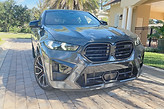
PRACTICAL PLANET SAVING
I’ve never met a soul who wished for the end of our planet and I’ll bet you haven’t either. So why aren’t we all driving electric vehicles? The political class currently occupying DC and California insist that we should abandon petrol ASAP and plug in for a brighter future. More than a few of these elected and appointed leaders compose EV regulations while their drivers fire up their big petrol-powered SUVs a bit early so their departure is nicely comfortable.
Don’t get me wrong, I enjoy driving new electric vehicles. They’re quiet, quick and often less expensive to fuel up than gasoline counterparts, especially if you have a 220/240 EV charger in your garage. And if you have solar on your roof, most of your fuel is free. For many, lucky enough to own a single-family dwelling in a sunny climate, the benefits offset the much higher price of an electric vehicle. That still leaves a good chunk of the American public out of this rosy picture.
The political class and EV evangelists counter that fast charging is getting nearly as convenient as a pit stop at the local gas station. Sorry, just not true. A high-speed Level 3 charger that can output 350kW of direct current (DC) is not easy to locate and few of the current crop of electric vehicles can accept that rapid a charge. For those pricy EVs that can, a 15-minute “fill-up” is possible, as long as it’s a nice mild day out. But if that’s the only way you charge the battery, you’ll shorten its life. And that battery replacement is about 12-grand, not the 100-buck parts store visit.
I don’t wish to bum readers out on an EV future. It’s not at all gloomy, unless we continue to rush headlong into pure battery electric power and leave many of our countrymen stuck without the freedom of mobility. The good news is that our entire vehicle fleet is becoming much more fuel efficient. My family vehicle is a reasonably sized, well equipped Mercedes GLC-300 that averages high 20’s low 30’s miles-per-gallon fuel efficiency. That’s about the same MPG as our MINI Cooper coupe used to average.


Then there’s hybrid gas/electric power choices available where the initial cost has come way down and you have even better fuel efficiency, especially around town, along with long range for trips and abundant quick fill-up opportunities. And a relatively new entrant in the market is the plug-in hybrid (PHEV) which in my view should become a natural step to pure battery electric vehicles.
Many early PHEVs were “compliance vehicles” with just enough electric range at lower speeds to get into mostly European cities that required EV operation. But that’s changed. I recently spent a week in Mitsubishi’s Outlander PHEV, an SUV big enough to haul seven passengers in nice style with good performance. Its window sticker displays 64-MPG in gas/electric mode. I drove all over the island on electric power and made a run to Jacksonville when the engine finally started. The result was 73.6-MPG for a week of normal driving. That’s the kind of transition to a battery-only future we can live with.
THE FINE PRINT
2023 Mitsubishi Outlander SEL Premium
TYPE: Front-engine, all-wheel-drive
ENGINE: 2.4-liter Turbo & I-4
HORSEPOWER: 248 @ 5,000 RPM
TORQUE: 332 lb.ft. @ 1,300 – 4,500 RPM
BASE PRICE: $48,145
AS TESTED: $52,200
FUEL CONSUMPTION: 25-city, 27-highway, 26-combined




